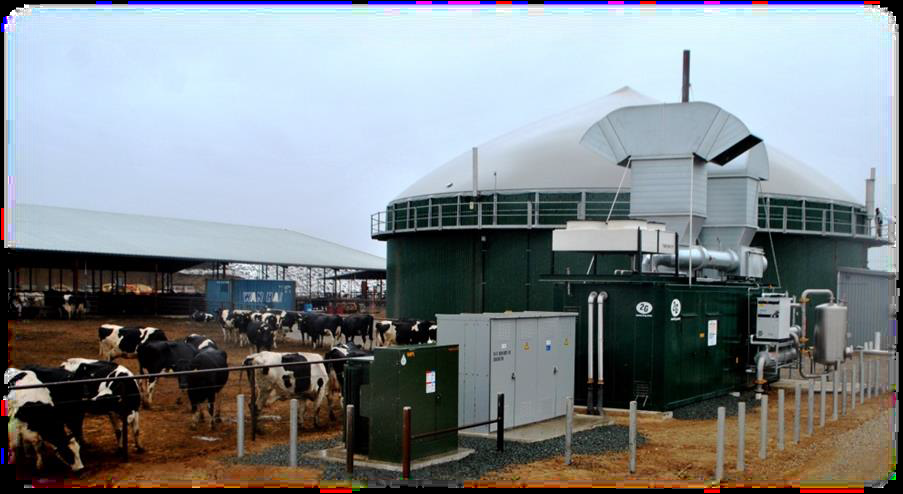 At the request of Dairy Cares, Ramboll Environ, formerly known as ENVIRON, prepared an analysis of the projects identified by the California Air Resources Board (ARB) to receive funds from the cap-and-trade auction proceeds. This study concluded Anaerobic digesters on dairies are one of the best investments of auction proceed funds, provide immediate reductions of GHGs upon completion of construction, and further vitally important statewide goals that will allow California to comply with the overall goal of reducing GHG emissions 80 percent below 1990 levels by 2050. Additional allocation of funds to incentivize the construction of more digesters in the state will enable California to reach its climate change goals sooner.
At the request of Dairy Cares, Ramboll Environ, formerly known as ENVIRON, prepared an analysis of the projects identified by the California Air Resources Board (ARB) to receive funds from the cap-and-trade auction proceeds. This study concluded Anaerobic digesters on dairies are one of the best investments of auction proceed funds, provide immediate reductions of GHGs upon completion of construction, and further vitally important statewide goals that will allow California to comply with the overall goal of reducing GHG emissions 80 percent below 1990 levels by 2050. Additional allocation of funds to incentivize the construction of more digesters in the state will enable California to reach its climate change goals sooner.
Excerpts from Ramboll Environ Study
Overview of Dairy Digester Greenhouse Gas Reduction Cost-Benefit Analysis
California’s Assembly Bill 32 (AB 32) commits California to reducing state greenhouse gas (GHG) emissions to 1990 levels by the year 2020. A key aspect of AB 32 is the Cap-and-Trade Regulation (Cap-and-Trade), which allows entities to sell and purchase allowances and offset credits to meet their requirements under the cap. The proceeds from the auction are used to fund programs that support the goals of AB 32, including projects that further reduce GHG emissions. A three-year investment plan, which was released on May 14, 2013, outlined the priority investments for the auction proceeds for fiscal years 2013-14 through 2015-16. These priority investments range from high-speed rail, to energy efficiency retrofits, to agricultural management (including anaerobic digesters).
Anaerobic digesters are expensive to build, but are a proven and highly effective method of reducing GHGs, particularly methane, from agriculture. As such, digesters are a smart investment of auction proceeds (i.e., provide a low cost per amount of GHG reductions), particularly in light of their ability to substantially reduce short-lived climate pollutants (SLCPs) and their potential to provide significant criteria pollutant reductions and benefits to disadvantaged communities. This study compares projects considering both economics and emissions to provide helpful information for future investment of auction proceeds in California.
California Statewide Goals
In addition to providing a high return on investment (i.e., low cost per emissions reduced), dairy digesters also further two statewide goals related to GHGs as described below.
California’s GHG Reduction Targets
Two executive orders have been signed that establish the statewide GHG reduction targets through 2050:
Executive Orders S-3-05 and B-30-15. Executive Order S-3-05, which was signed by Governor Arnold Schwarzenegger on June 1, 2005, established the following targets:
• By 2010, reduce GHG emissions to 2000 levels;
• By 2020, reduce GHG emissions to 1990 levels; and
• By 2050, reduce GHG emissions to 80 percent below 1990 levels.
Executive Order B-30-15, which was signed by Governor Edmund G. Brown, Jr. on April 29, 2015, established an interim benchmark to maintain California’s reduction efforts on the path to achieving the 2050 goal originally established by the previous executive order. Executive Order B-30-15 established the
following GHG reduction target for the state:
• By 2030, reduce GHG emissions to 40 percent below 1990 levels.
Role of Digesters
The majority of projects receiving proceeds Cap-and-Trade funding reduce carbon dioxide emissions; in contrast, digesters primarily reduce emissions of methane, an SLCP. Thus, digesters are one of the only types of projects fundable via auction proceeds that help the state meet both the overall goal of reducing GHGs and the important near-term goals of reducing SLCPs. In addition, many digester projects, including all five projects funded in 2015 via the California Department of Food and Agriculture-administered Dairy Digester Research and Development Program, will be constructed in disadvantaged communities and provide economic and environmental benefits to those communities.
Read the study for the conclusion and charts.
Image Credit: from California Dairy Research Foundation “Dairy Biogas Digester Development Gets Boost from New Programs, Incentives, Partnerships“. Image is the biogas digester at New Hope Dairy in Galt, Calif. began generating electricity in 2013. The system is capable of generating 450 kilowatts, enough electricity to power about 250 single-family homes.










